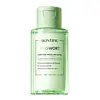What's inside
What's inside
 Key Ingredients
Key Ingredients

 Benefits
Benefits

 Concerns
Concerns

No concerns
 Ingredients Side-by-side
Ingredients Side-by-side

Water
Skin ConditioningPEG-6 Caprylic/Capric Glycerides
EmulsifyingGlycerin
HumectantPropanediol
SolventPentylene Glycol
Skin ConditioningMadecassoside
AntioxidantEmiliania Huxleyi Extract
Skin ConditioningAloe Barbadensis Leaf Extract
EmollientArtemisia Vulgaris Extract
Skin ConditioningCalendula Officinalis Flower Extract
MaskingSea Water
HumectantSaccharide Isomerate
HumectantCopper Gluconate
Skin ConditioningZinc Gluconate
Skin ConditioningCaprylyl Glycol
EmollientAllantoin
Skin ConditioningEthylhexylglycerin
Skin ConditioningCitric Acid
BufferingSodium Phytate
Sodium Citrate
BufferingTocopherol
AntioxidantHydrogenated Ethylhexyl Olivate
EmollientHydrogenated Olive Oil Unsaponifiables
EmollientMagnesium Aspartate
Skin Conditioning1,2-Hexanediol
Skin ConditioningPhenoxyethanol
PreservativeButylene Glycol
HumectantOctanediol
Water, PEG-6 Caprylic/Capric Glycerides, Glycerin, Propanediol, Pentylene Glycol, Madecassoside, Emiliania Huxleyi Extract, Aloe Barbadensis Leaf Extract, Artemisia Vulgaris Extract, Calendula Officinalis Flower Extract, Sea Water, Saccharide Isomerate, Copper Gluconate, Zinc Gluconate, Caprylyl Glycol, Allantoin, Ethylhexylglycerin, Citric Acid, Sodium Phytate, Sodium Citrate, Tocopherol, Hydrogenated Ethylhexyl Olivate, Hydrogenated Olive Oil Unsaponifiables, Magnesium Aspartate, 1,2-Hexanediol, Phenoxyethanol, Butylene Glycol, Octanediol
Water
Skin ConditioningPEG-7 Glyceryl Cocoate
EmulsifyingDipropylene Glycol
HumectantPEG-6 Caprylic/Capric Glycerides
EmulsifyingArtemisia Vulgaris Extract
Skin ConditioningAllantoin
Skin ConditioningCentella Asiatica Extract
CleansingCitric Acid
BufferingEthylhexylglycerin
Skin ConditioningCeramide AP
Skin ConditioningCeramide As
Skin ConditioningDipotassium Glycyrrhizate
HumectantCeramide Ns
Skin ConditioningCeramide Ng
Skin ConditioningCeramide EOP
Skin ConditioningCeramide NP
Skin ConditioningDisodium EDTA
Potassium Benzoate
PreservativeBifida Ferment Filtrate
Skin ConditioningWater, PEG-7 Glyceryl Cocoate, Dipropylene Glycol, PEG-6 Caprylic/Capric Glycerides, Artemisia Vulgaris Extract, Allantoin, Centella Asiatica Extract, Citric Acid, Ethylhexylglycerin, Ceramide AP, Ceramide As, Dipotassium Glycyrrhizate, Ceramide Ns, Ceramide Ng, Ceramide EOP, Ceramide NP, Disodium EDTA, Potassium Benzoate, Bifida Ferment Filtrate
 Reviews
Reviews

Ingredients Explained
These ingredients are found in both products.
Ingredients higher up in an ingredient list are typically present in a larger amount.
Allantoin is a soothing ingredient known for its protective and moisturizingg properties. Because of this, it is often added to products with strong active ingredients.
Studies show higher concentrations of this ingredient can promote wound healing.
Though it can be derived from the comfrey plant, allantoin is produced synthetically for cosmetic products to ensure purity.
Learn more about AllantoinArtemisia Vulgaris Extract is more commonly known as the common mugwort. It has strong antioxidant properties and helps soothe irritation.
Antioxidants protect skin from damage and the signs of aging.
This plant contains the compounds saponins, glycosides, flavanoids, protein, triterpenoids.
The common wugwort has been used in traditional Indian, Chinese, and European medicines to treat gastrointestinal diseases.
Learn more about Artemisia Vulgaris ExtractCitric Acid is an alpha hydroxy acid (AHA) naturally found in citrus fruits like oranges, lemons, and limes.
Like other AHAs, citric acid can exfoliate skin by breaking down the bonds that hold dead skin cells together. This helps reveal smoother and brighter skin underneath.
However, this exfoliating effect only happens at high concentrations (20%) which can be hard to find in cosmetic products.
Due to this, citric acid is usually included in small amounts as a pH adjuster. This helps keep products slightly more acidic and compatible with skin's natural pH.
In skincare formulas, citric acid can:
While it can provide some skin benefits, research shows lactic acid and glycolic acid are generally more effective and less irritating exfoliants.
Most citric acid used in skincare today is made by fermenting sugars (usually from molasses). This synthetic version is identical to the natural citrus form but easier to stabilize and use in formulations.
Read more about some other popular AHA's here:
Learn more about Citric AcidEthylhexylglycerin (we can't pronounce this either) is commonly used as a preservative and skin softener. It is derived from glyceryl.
You might see Ethylhexylglycerin often paired with other preservatives such as phenoxyethanol. Ethylhexylglycerin has been found to increase the effectiveness of these other preservatives.
This ingredient is derived from caprylic and capric acids. It is an emulsifier with emollient properties.
According to the manufacturer, it is hydrophilic and soluble in aqueous solutions (water). They also state this ingredient is stable in a medium pH range (~5 - 8).
As an emulsifier, it helps make oils and oil-soluble ingredients more soluble in water.
Learn more about PEG-6 Caprylic/Capric GlyceridesWater. It's the most common cosmetic ingredient of all. You'll usually see it at the top of ingredient lists, meaning that it makes up the largest part of the product.
So why is it so popular? Water most often acts as a solvent - this means that it helps dissolve other ingredients into the formulation.
You'll also recognize water as that liquid we all need to stay alive. If you see this, drink a glass of water. Stay hydrated!
Learn more about Water